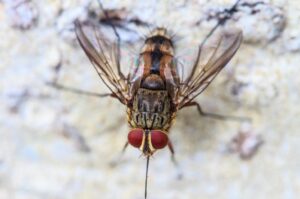Of the many flies you encounter in your home, you may be unaware of cluster flies as distinct species. They’re more nuisance than hazardous. If you treat them inside your house with long-lasting pesticides, their dead bodies can attract larder beetles and other scavengers, which may create more troublesome issues in your home. They also like to parasitize earthworms, which can do lots of good for your garden. The best way to prevent cluster flies from invading is to know how and when they get in, and eliminate their opportunities to enter.
What are cluster flies?
It’s easy to confuse cluster flies with house flies. However, cluster flies are bigger and slower. They’re eight to ten millimetres long and have dark grey bodies. You can distinguish them from house flies by the light and dark-coloured patches on their abdomens and the gold-coloured hairs on their thoraces.
What attracts them?
Although you typically notice cluster flies indoors in late winter and early spring, they moved into your home in early fall. They are drawn to the upper and sun-facing sides of large structures such as your house and move in through holes.
They stay inside houses and other buildings over the winter. On warmer days, some may emerge indoors and gather around light sources like lamps and windows.
How do you keep them out?
The best time to prevent cluster flies is during the late summer. Take these steps to reduce entry points:
- Install insect screens on windows, doors, and vents.
- Add or replace the weatherstripping on your windows and doors.
- Use caulking to fill in cracks around windows, doors, and any other gaps.
- Periodically check your home for new access points. For example, inspect your screens for rips and ensure they fit properly. Keep an eye out for new cracks or gaps, and seal them off immediately.
- Apply a residual pesticide around windows, door-frames, and vents in early August and reapply as needed. Do not apply residual pesticides for cluster flies indoors.
If you already have a problem with cluster flies, don’t panic. They don’t lay eggs inside homes. You can kill them with a fly swatter or vacuum-cleaner, but they may stain surfaces or release an unpleasant odour. You can also purchase commercial trapping devices and pesticide solutions. A pest management professional can advise on the best solution for you.
Cluster fly control across western Canada
Whatever your insect control issues, Poulin’s Pest Control has a solution. Our experts provide extermination and pest prevention services for residential and commercial clients in Alberta, Saskatchewan and Manitoba. Contact us to schedule an on-site evaluation.

